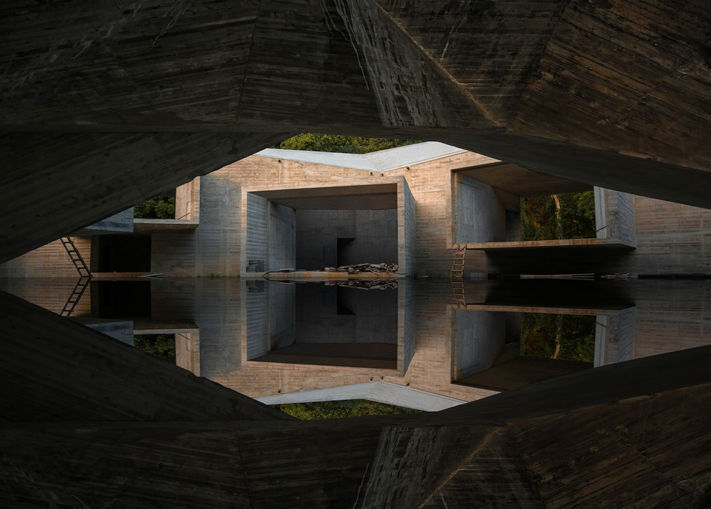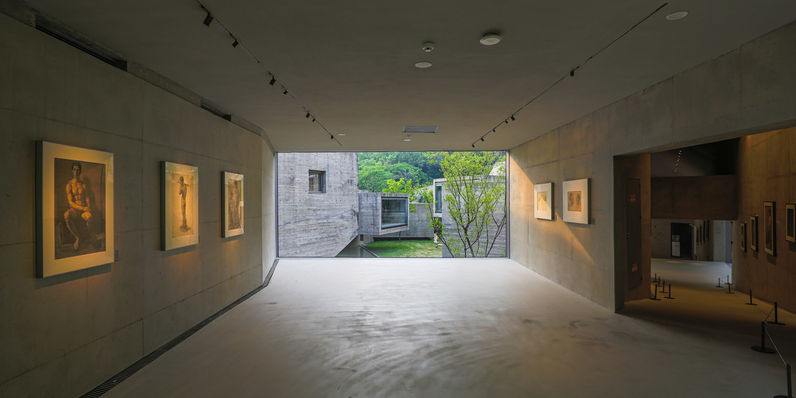
Xiao Feng Art Museum
ZAO/Zhang Ke Architecture Office
Project Name: Xiao Feng Art Museum
Location: Hangzhou, Zhejiang Province, China
Design Team: ZAO/ Zhang Ke Architecture Office
Total Floor Area: 1,298 m²
Completion: 2025
Photography: Sumin, DONG Image, Sheng Yang, Qingshan Wu, Arch Nago
Feature: ZAO/ Zhang Ke Architecture Office 's "Xiao Feng Art Museum" demonstrates how innovative serpentine architectural form integration strategies and ink-infused concrete materiality design philosophy fusion techniques can transform a museum dedicated to painter couple Xiao Feng and Song Ren at the foot of Daci Mountain into a culturally profound sanctuary of artistic contemplation and traditional scholar garden reinterpretation.
This 1,298-square-meter museum dramatically coils around an interior courtyard landscape, presenting itself as a profound meditation on contemporary Chinese cultural institution integration, traditional spatial wisdom adaptation, and modern architectural innovation fusion. Through carefully considered spatial organization and material selection, it creates an exhibition experience that seamlessly weaves functionality with cultural poetic sensibility.
The project's most compelling design feature lies in its fundamental response and reimagining of the traditional introverted Chinese scholar's garden typology. A serpentine linear building structure serves not only as an architectural element but becomes the core of spatial organization, ensuring the building volume gracefully creates contemplative moments while preserving dynamic visual connections to the surrounding landscape. This design strategy creates continuous dialogue between interior introspection and exterior nature, achieving a harmonious spatial coexistence effect.
ZAO/ Zhang Ke Architecture Office 's design language fluently expresses contemporary interpretation of cultural heritage, employing innovative applications of ink-infused concrete to redefine museum experiences. The exhibition circulation follows the circular form of the building, which becomes quite narrow at some points and expands to larger volumes at others to open up exterior space. This bold spatial modulation strategy not only adds experiential richness to the journey but cleverly accommodates the complex functional demands of intimate art viewing and expansive gathering spaces.
Most remarkably, the architects create comfortable sensory experience environments between different exhibition zones through clever manipulation of material innovation and spatial sequences. Ramps provide access to different levels, facilitating multifaceted spatial experiences in parts of the building with various heights. The polygonal form is broken up toward the interior courtyard with protruding boxes, which open to the courtyard with panorama windows or even permit views through the building from the interior courtyard of the hilly landscape outside the museum, creating seamless transitions between contemplation and landscape observation.
Material strategy continues this harmonious coexistence design philosophy between architecture and nature. The entire building shell was created with concrete colored with black ink and processed on site. This darkened surface absorbs and reflects light with subtle complexity, its material homogeneity creating striking counterpoint to the organic textures of the natural setting. Natural lighting conditions and artificial lighting bring the homogeneity of materials and the polygonal snake form into vibrant contrast with surrounding nature.
Sustainability and cultural sensitivity guided key design decisions, from the building's organic integration with site topography to contemporary reinterpretation of traditional spatial sequences, demonstrating how cultural memory and architectural innovation can coexist. The building cleverly adapts to the site's natural slope through a ramp system, creating spatially rich experiences at different levels while minimizing intervention to the original terrain.
Design Team ZAO/ Zhang Ke Architecture Office was founded in 2001 by Zhang Ke, and has emerged as one of China's most critically acclaimed and innovative design practices. The Beijing-based firm transcends conventional professional boundaries, engaging in urban planning, architecture, landscape design, interior design, and product development with equal sophistication.
Under Zhang Ke's leadership, the studio has distinguished itself through intellectually rigorous interventions in historically and culturally significant contexts. Rather than pursuing sensational formal gestures, ZAO maintains a disciplined focus on realizing thoughtful urban visions grounded in deep contextual understanding. Their portfolio spans transformative hutong renewal projects in Beijing's historic core, sensitive interventions across Tibet's dramatic landscapes, and institutional commissions including the Novartis Campus Building in Shanghai and the Xiao Feng Art Museum in Hangzhou.
The firm's critical approach has garnered international recognition, including the prestigious Alvar Aalto Medal in 2017, the Aga Khan Award for Architecture in 2016, and the International Award Architecture in Stone in 2011. Zhang Ke's academic engagement as Visiting Professor at Harvard University Graduate School of Design since 2016 further reinforces the studio's commitment to advancing architectural discourse.
The firm's design philosophy emphasizes that architecture should transcend surface form, capturing the cultural depth and spirit of place. Through careful orchestration of volume, light, materiality, and spatial sequence, ZAO believes the best architecture results from comprehensive strategies through rigorous conceptual intent, deep understanding of historical and cultural context, and attention to detail. ZAO believes architecture should transform cultural memory into contemporary spatial experiences, creating unique site-responsive architectural works through strategic spatial organization and material selection.
Beyond practice, through thoughtful integration of traditional spatial wisdom with modern construction methods, current sustainability strategies application, and time-tested architectural principles, ZAO has established itself as a significant contributor to contemporary Chinese architectural discourse, creating architectural works that are both functional and embrace spatial poetry and cultural depth. The firm is currently led by Zhang Ke alongside collaborators including Fang Shujun, Brad Hooks, and an international team, occupying a unique position within China's contemporary architectural practice, focusing on creating culturally rooted, elegant, and innovative spatial experiences.
1298 m²
Hangzhou, China
2025




























